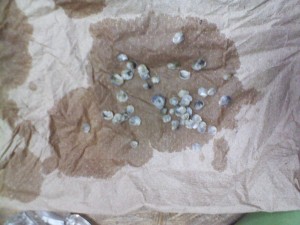
This is a prelim samples in non-predator water. The middle container is the control with out spat. The one to the left is the 18 hour run and the right is a 24 hour run.

We try 50 spat first per a container. This first run is checking to see how many spat will be needed for the research.
Who We Are
What We Did
Mostly I washed bottles, beakers, and flask using the 3 rise tap water and 3 rise D.I. water.
I also went on a surface water sample collecting.
Also shadow and helped Melissa with her oyster spats. During the pre-samples.
What We Learned
There is a reason why some oysters have thicker shells than others. Some reasons maybe be toxins and others can be predators.
Questions We Have
If I remember correctly. Checking to see if predator water will cause the spat to make a harder shell. This is what we are checking to see with the oyster spats. Hopefully this research can be less invasive than the crushing test.
Connections to Teaching
When we are checking on an experiments always remember we need a control to compare the samples to
